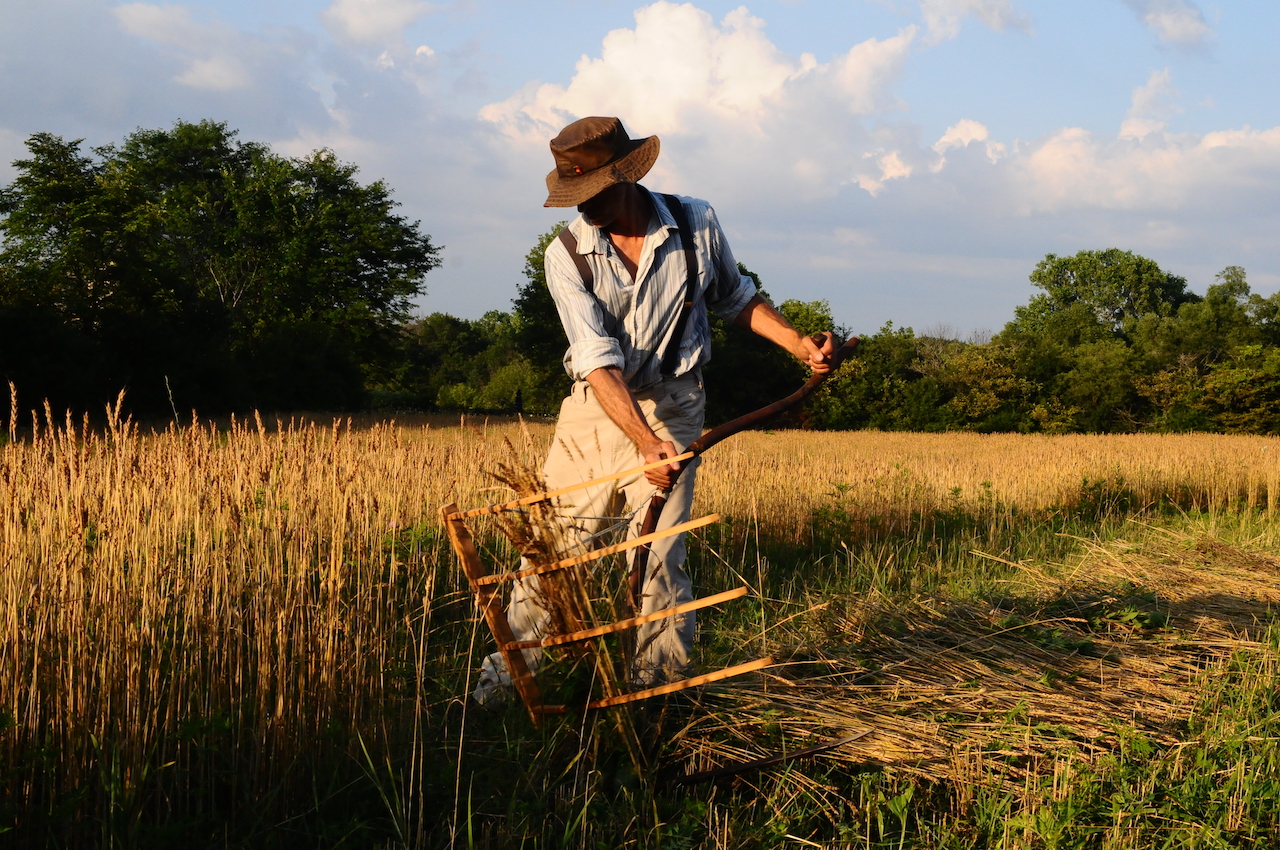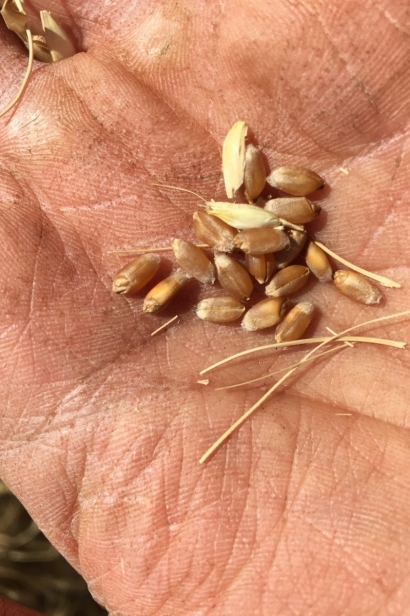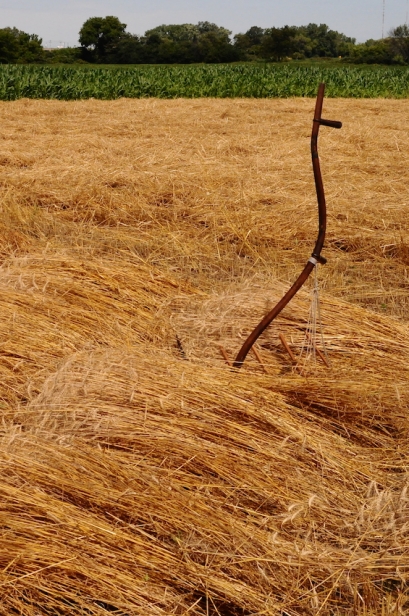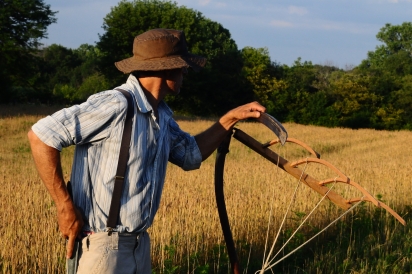Immigrant Wheat
Although wheat is the principal cereal grain grown in the United States today, there was no wheat in the New World prior to European settlement. The peoples of North and South America had discovered and domesticated many staple food crops, but not wheat, which immigrated alongside our ancestors. There have been many varieties of wheat grown in America, and one of the most famous varieties is called Turkey Red. It was responsible for making the Midwest the breadbasket of the world.
Every immigrant has a story to tell, even immigrant wheat. Turkey Red’s story is unusual, because it immigrated to the New World not once, but twice. Both journeys tell a unique story.
The first time Turkey Red came to the Americas, it came with Russian Mennonite immigrants in the 19th century. Mennonite farmers brought wheat from the area of Russia that is now known as Crimea. Sometime after 1873, a wheat variety dubbed Turkey Red emerged as the signature wheat of the Great Plains. Turkey Red was valued for its hardiness, high yield and high protein content as well as a smooth, mild flavor.
Turkey Red is classified as winter wheat, which is planted in the fall, grows for a few weeks, and then goes dormant for the winter. Because it has already set roots and has some foliage above ground, winter wheat grows quickly once the frost leaves the ground in spring. Winter wheat is able to collect and utilize the rain and sun in the month of April, a time when spring crops cannot be planted.
Once the most popular variety of wheat grown in the United States, Turkey Red was phased out soon after World War II. New wheat varieties were being developed by artificially crossing different types of wheat. Botanists were seeking a crop with shorter stalks that would tolerate an extensive application of fertilizer. The new wheat varieties with shorter stalks could grow large heads of wheat without falling over and breaking. The new varieties, combined with cheap and available nitrogen fertilizer, soon pushed out old varieties like Turkey Red from the marketplace.
In the early 1990’s, a Kansas wheat farmer named Bryce Stephens became curious about the lost Turkey Red, and went looking for it. He was able to find some Mennonite farmers in Kansas still growing the historic variety. These farmers had been saving seed from their harvests for most of the 20th century. Stephens soon had a thriving niche business of growing and selling Turkey Red wheat and his daughter, Demetria, still grows Turkey Red today, planting around 200 acres most years.
I went on a quest for the original Turkey Red in 2015. Although I had been growing modern Turkey Red on my farm for several years by then, I was curious about the provenance of my seed line. I had grown Turkey Red from the Stephens farm, Heartland Mills and from Kansas State University. I noticed that the three different lines had somewhat varied characteristics. One seemed to germinate faster, and another had a shorter stalk and made a cream-colored flour. Were they all the same wheat, and were any of them the authentic Turkey Red of the 1870’s?
To answer this question, I turned to the USDA Small Grains Collection. The USDA maintains seed of most important crops, and they possess over 50,000 different varieties of wheat. Most of these varieties can be requested and experimented with.
I requested Turkey Red from the USDA, and planted it in the fall of 2015. The collection would only share 5 grams of seed, about 125 seeds in total, so I put the precious seeds into the ground and excitedly waited for them to grow. I planted the three modern strains of Turkey Red alongside, so I could make comparisons.
While I waited for the test wheat to grow and mature, I had time to learn more about where and when the USDA’s Turkey Red was collected. Remarkably, the Turkey Red wheat in the USDA collection was collected in Nebraska by the Vavilov Institute of Plant Industry, in Leningrad (now St. Petersburg), Russia in 1923.
The USDA, somehow, lost its native sample of Turkey Red over the course of the 20th century, and only had seed from the Russian line. There was an exchange of seed between the USDA and the Vavilov Institute during the 1990’s, and that is when Turkey Red made its second immigration to the US.
The Vavilov Turkey Red, it turned out, had an even more interesting immigrant story to tell than the first variety. The Vavilov Institute was established in 1921 and soon had the largest collection of seed in the world, a distinction it holds to this day. The Institute collected seed from practically every cultivated plant known, and maintained it (like the USDA does) by regularly planting the seeds and collecting the new seed from the mature plants. On the eve of World War II, there were 187,000 varieties of plants (of which about 40,000 were food crops) in the Vavilov’s seedbank.
In early September of 1941, right around planting time for winter wheat like Turkey Red, the last road to Leningrad was cut off by the advancing German army. The costliest siege in human history played out over the next 28 months. Up to 1.5 million Russian civilians and defenders died during the Siege of Leningrad, many of them by starvation. Civilians during the first winter were only allotted 125 grams of bread per day, which consisted of at least 50% sawdust and other inedible ingredients.
Hungry townspeople, very reasonably, turned to the seed stores at the Vavilov Institute for a food source. There were literally tons of edible food in the collection. The phenomenally dedicated botanists of the Vavilov, however, felt it was their duty to protect the seed stores throughout the siege. They even burned furniture to keep the potatoes from freezing. Nine of the Vavilov’s staff died of starvation during the siege, while guarding and preserving the seed collection for the future.
Upon learning this, I felt a little more reverential about the wheat in my test plot. Before, my Turkey Red wheat test just seemed like a quirky bit of backyard botany. Now I knew people had died to preserve the seeds I planted.
Remarkably, the Vavilov Turkey Red showed unique characteristics as it neared maturity. Most astounding was the vibrant red color in its wheat stems. I had never seen those distinct red colored stems in any of the modern Turkey Red I had worked with, but was it distinct in flavor? To answer that, I would have to keep growing out the wheat until there was enough to bake a loaf of bread.
Since the 2015 planting, I have carefully collected and re-planted the Vavilov Turkey Red each fall to increase the stock. I have also been growing out another strain of Turkey Red, called Wisconsin Pedigree No. 2. This variety was originally collected by the University of Wisconsin around 1905. The University improved the strain and released it as pedigreed seed in 1917. The Wisconsin No. 2 also develops striking red stems as it matures.
It’s clear to me that both the Vavilov Turkey Red and the Wisconsin No. 2 preserve characteristics of Turkey Red that are lost in the modern versions being sold today. Whether the modern Turkey Red is in fact another variety, or has changed subtly over the decades, is hard to tell. Reliable seed-saving is difficult to do on a farm. It’s easy for a seed stock to be contaminated. Also, the large agricultural machines we use today for planting, harvesting and cleaning all place evolutionary pressure on a plant over time. This pressure may have caused the red color to die out.
The red color of the old Turkey Red is caused by anthocyanin, the same substance that makes leaves turn colors in the fall. The coloring of anthocyanin is actually present throughout the life cycle of the plant, but is covered up by green chlorophyll during the growing season and when the plant ceases to photosynthesize, the green color fades and the red shades are revealed. Anthocyanins are known antioxidants with other observed health benefits.
By the fall of 2017, the stock of Vavilov Turkey Red on the farm, Anarchy Acres, increased to five pounds. In 2018, the expected harvest is over 100 pounds. This will be enough to make a couple loaves of bread and still plant more than a half acre in the fall of 2018. For 2019, we hope to be selling flour made from Vavilov Turkey Red, the twice-immigrated wheat that survived the Siege of Leningrad.








